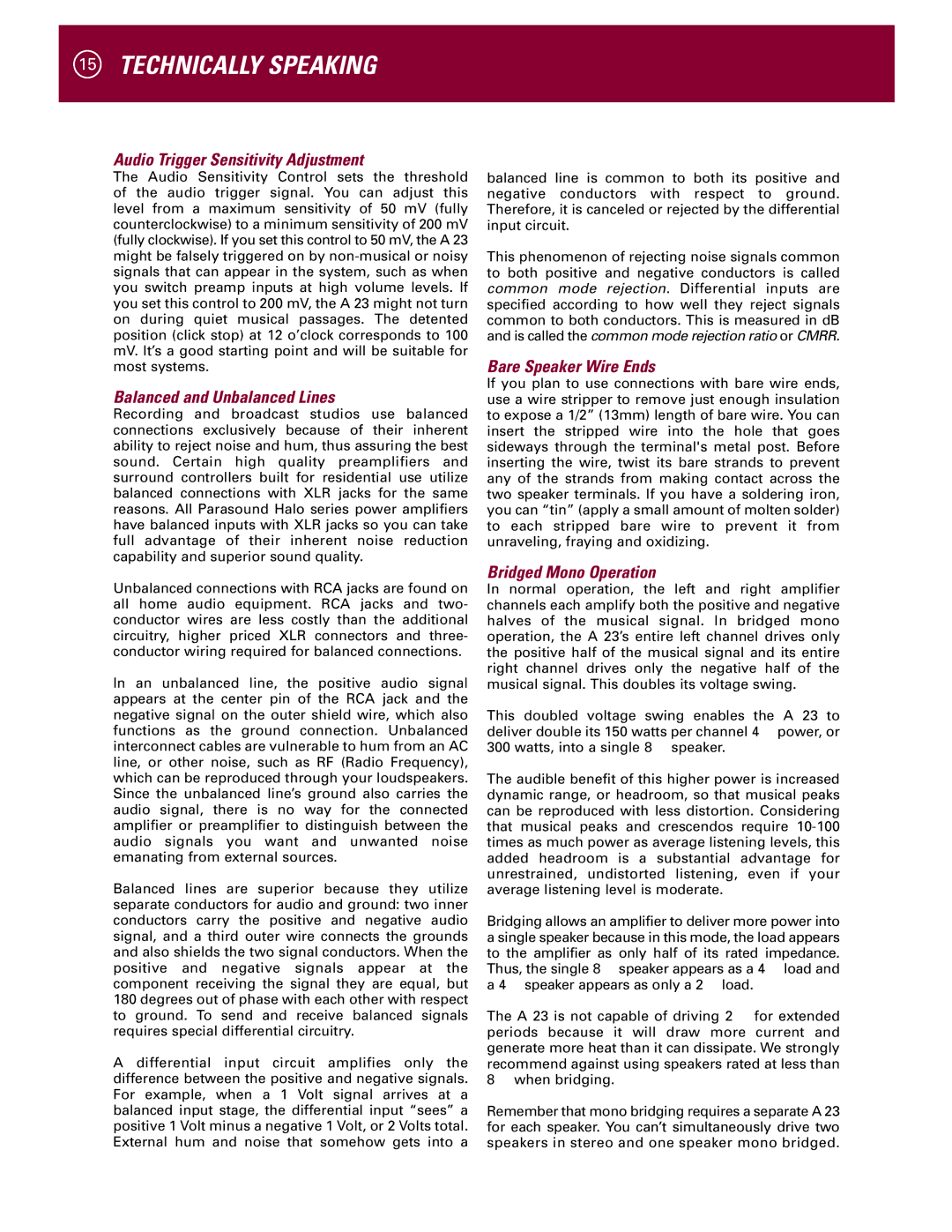Audio Trigger Sensitivity Adjustment
The Audio Sensitivity Control sets the threshold of the audio trigger signal. You can adjust this level from a maximum sensitivity of 50 mV (fully counterclockwise) to a minimum sensitivity of 200 mV (fully clockwise). If you set this control to 50 mV, the A 23 might be falsely triggered on by non-musical or noisy signals that can appear in the system, such as when you switch preamp inputs at high volume levels. If you set this control to 200 mV, the A 23 might not turn on during quiet musical passages. The detented position (click stop) at 12 o’clock corresponds to 100 mV. It’s a good starting point and will be suitable for most systems.
Balanced and Unbalanced Lines
Recording and broadcast studios use balanced connections exclusively because of their inherent ability to reject noise and hum, thus assuring the best sound. Certain high quality preamplifiers and surround controllers built for residential use utilize balanced connections with XLR jacks for the same reasons. All Parasound Halo series power amplifiers have balanced inputs with XLR jacks so you can take full advantage of their inherent noise reduction capability and superior sound quality.
Unbalanced connections with RCA jacks are found on all home audio equipment. RCA jacks and two- conductor wires are less costly than the additional circuitry, higher priced XLR connectors and three- conductor wiring required for balanced connections.
In an unbalanced line, the positive audio signal appears at the center pin of the RCA jack and the negative signal on the outer shield wire, which also functions as the ground connection. Unbalanced interconnect cables are vulnerable to hum from an AC line, or other noise, such as RF (Radio Frequency), which can be reproduced through your loudspeakers. Since the unbalanced line’s ground also carries the audio signal, there is no way for the connected amplifier or preamplifier to distinguish between the audio signals you want and unwanted noise emanating from external sources.
Balanced lines are superior because they utilize separate conductors for audio and ground: two inner conductors carry the positive and negative audio signal, and a third outer wire connects the grounds and also shields the two signal conductors. When the positive and negative signals appear at the component receiving the signal they are equal, but 180 degrees out of phase with each other with respect to ground. To send and receive balanced signals requires special differential circuitry.
A differential input circuit amplifies only the difference between the positive and negative signals. For example, when a 1 Volt signal arrives at a balanced input stage, the differential input “sees” a positive 1 Volt minus a negative 1 Volt, or 2 Volts total. External hum and noise that somehow gets into a
balanced line is common to both its positive and negative conductors with respect to ground. Therefore, it is canceled or rejected by the differential input circuit.
This phenomenon of rejecting noise signals common to both positive and negative conductors is called common mode rejection. Differential inputs are specified according to how well they reject signals common to both conductors. This is measured in dB and is called the common mode rejection ratio or CMRR.
Bare Speaker Wire Ends
If you plan to use connections with bare wire ends, use a wire stripper to remove just enough insulation to expose a 1/2” (13mm) length of bare wire. You can insert the stripped wire into the hole that goes sideways through the terminal's metal post. Before inserting the wire, twist its bare strands to prevent any of the strands from making contact across the two speaker terminals. If you have a soldering iron, you can “tin” (apply a small amount of molten solder) to each stripped bare wire to prevent it from unraveling, fraying and oxidizing.
Bridged Mono Operation
In normal operation, the left and right amplifier channels each amplify both the positive and negative halves of the musical signal. In bridged mono operation, the A 23’s entire left channel drives only the positive half of the musical signal and its entire right channel drives only the negative half of the musical signal. This doubles its voltage swing.
This doubled voltage swing enables the A 23 to deliver double its 150 watts per channel 4 Ω power, or 300 watts, into a single 8 Ω speaker.
The audible benefit of this higher power is increased dynamic range, or headroom, so that musical peaks can be reproduced with less distortion. Considering that musical peaks and crescendos require 10-100 times as much power as average listening levels, this added headroom is a substantial advantage for unrestrained, undistorted listening, even if your average listening level is moderate.
Bridging allows an amplifier to deliver more power into a single speaker because in this mode, the load appears to the amplifier as only half of its rated impedance. Thus, the single 8 Ω speaker appears as a 4 Ω load and a 4 Ω speaker appears as only a 2 Ω load.
The A 23 is not capable of driving 2 Ω for extended periods because it will draw more current and generate more heat than it can dissipate. We strongly recommend against using speakers rated at less than 8 Ω when bridging.
Remember that mono bridging requires a separate A 23 for each speaker. You can’t simultaneously drive two speakers in stereo and one speaker mono bridged.

